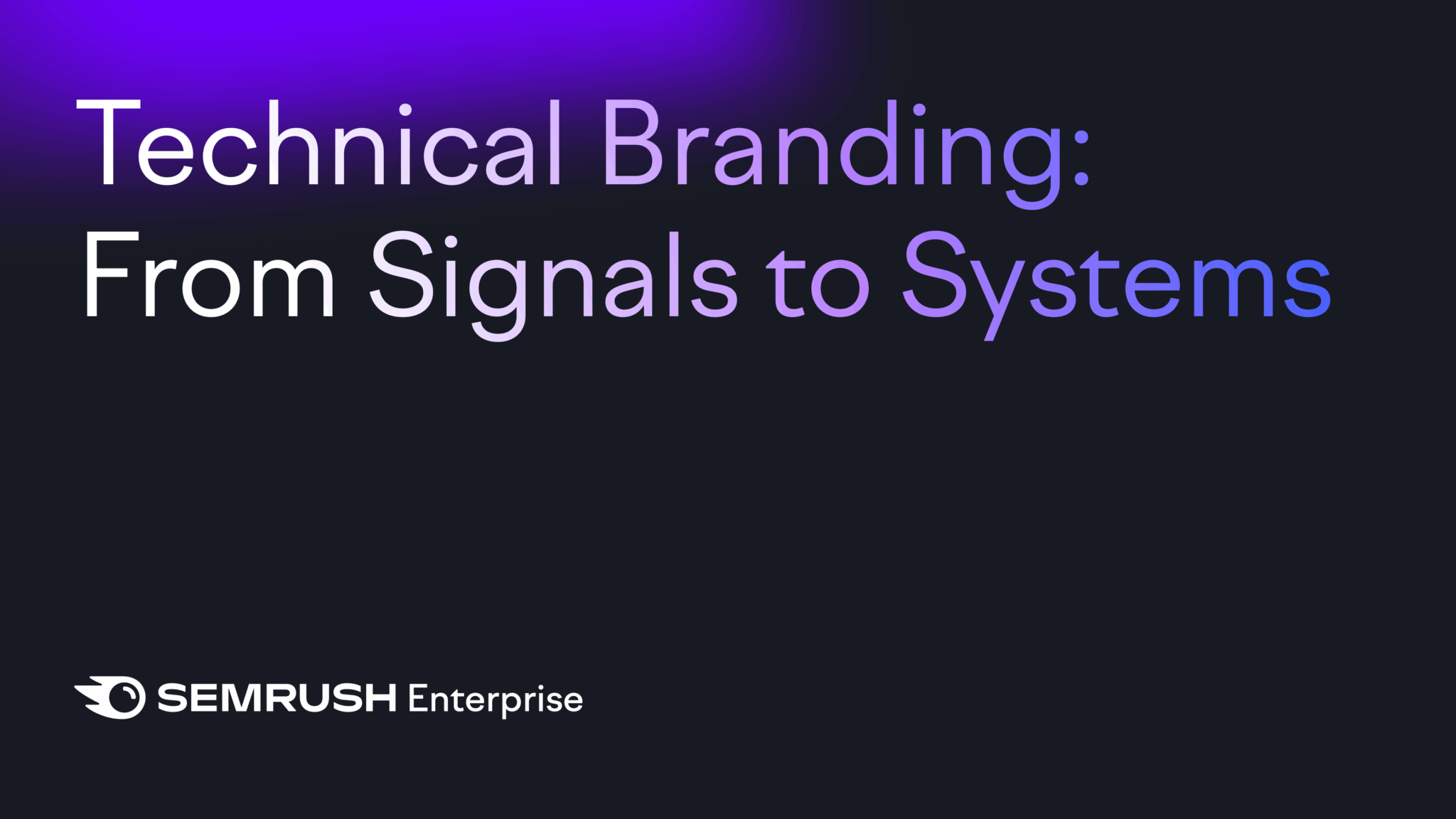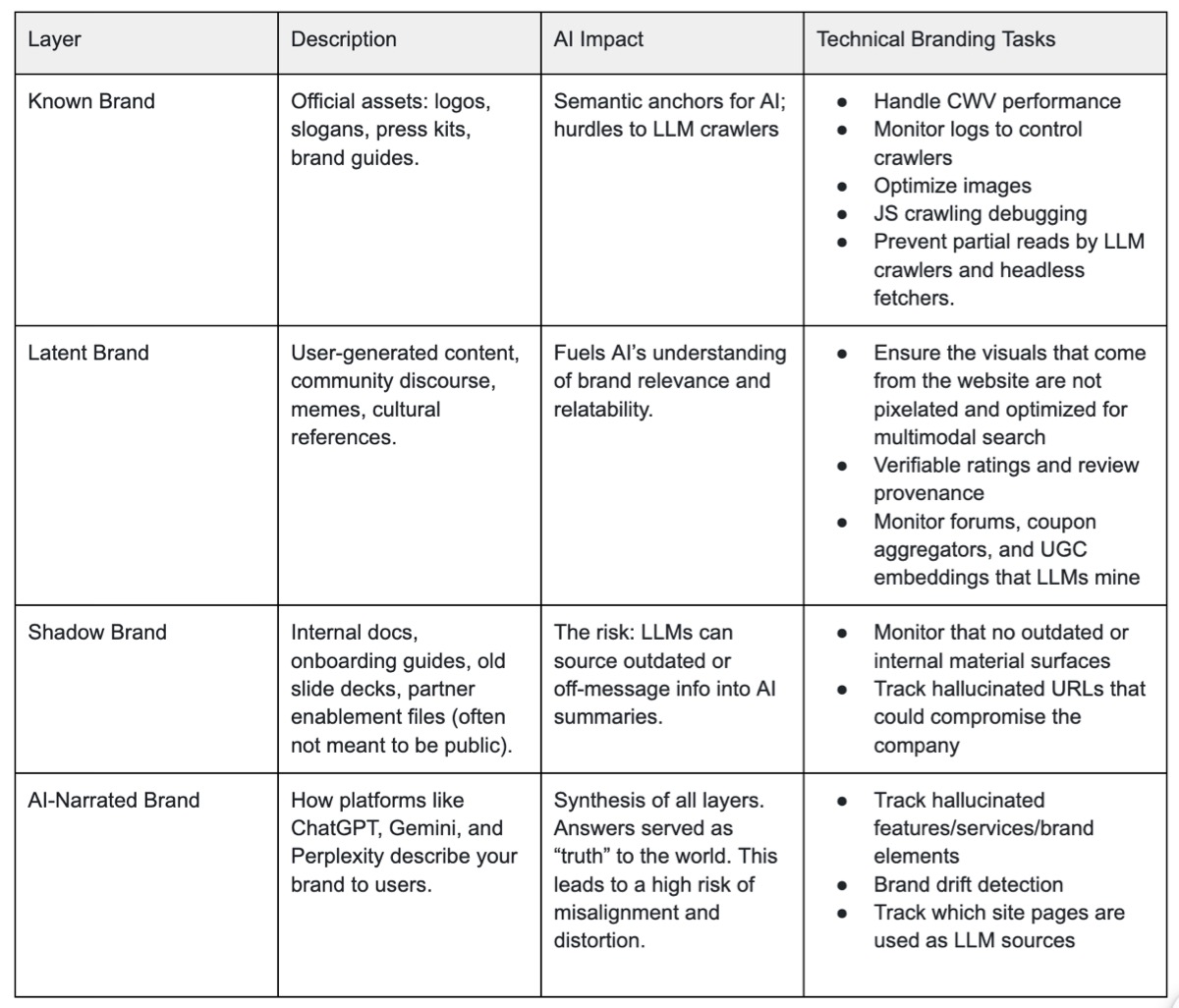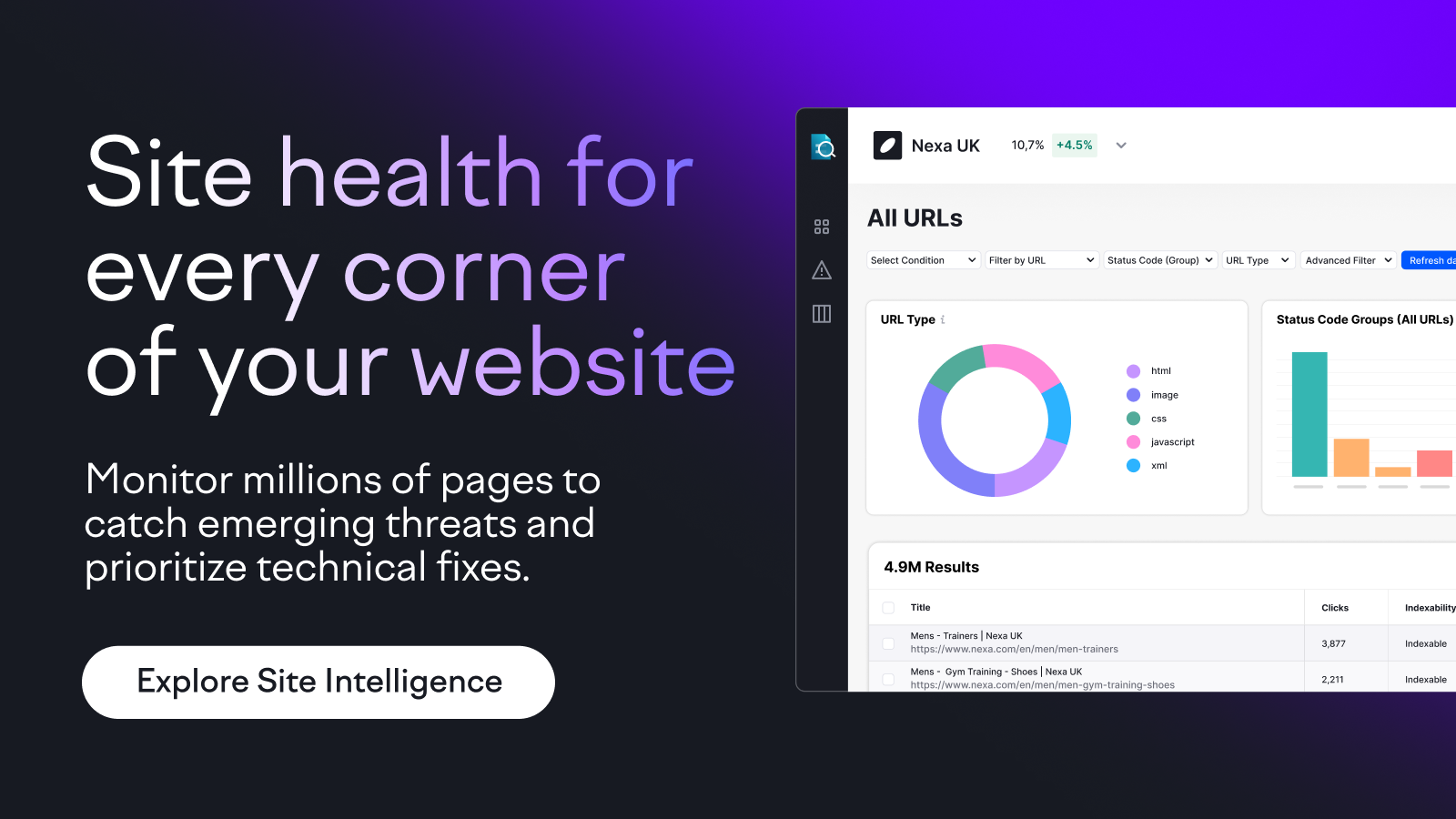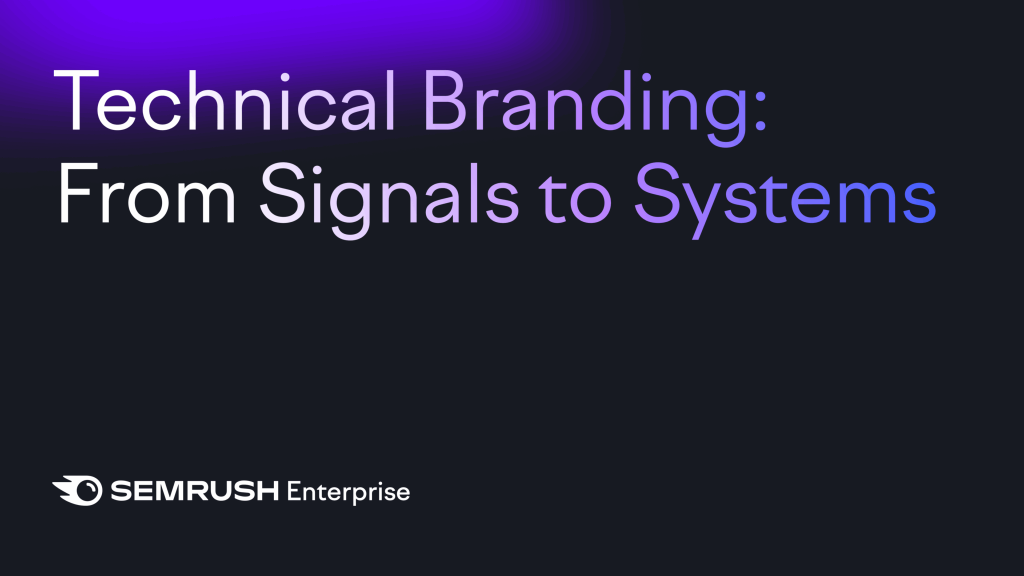The rise of technical branding in the age of AI search by Semrush Enterprise


Brand performance in generative search relies on measurable reputation and entity signals. But those signals are only as good as the infrastructure machines can fetch, parse, and trust.
Treat the website, feeds, and APIs as brand training data. Pair technical governance with brand strategy to stop narrative drift and preserve brand equity.
Search and brand are one system now, bridging the gap between intent and machine narration.
“Google doesn’t just index your pages – it indexes your reputation.” – Jono Alderson
That only happens when the site’s performance, semantics, and integrity make the brand easy to select. Machines prefer brands they can read clearly and trust. When the site shows the product, the proof, and the experience without friction, those systems recommend it more.
Branding has evolved, technical branding emerges
Technical branding is the engineering and governance of all machine‑facing surfaces (site, feeds, APIs, assets, and controls) so AI crawlers and agents construct, cite, and execute the brand correctly.
Focus on three levers:
- Speed.
- Semantics.
- Security.
Treat every output as training data and every failure mode (404s, drift, leakage) as brand erosion.
Brand stewardship now requires managing four distinct but interconnected layers. Each layer feeds AI training data differently and carries different risk profiles. Ignore any layer, and AI systems will construct your brand narrative without your input.
Technical branding at each brand layer

Brand equity from a technical standpoint means focusing on loading times, rendering, semantic code, and cybersecurity.
Technical branding turns infrastructure into brand equity. It reduces waste from hallucinated URLs, blocks exploit paths, and raises the chance of being cited in generative search results.
Technical branding tasks
Reframing some emerging marketing needs as technical branding helps tackle the four machine-facing control layers that make up the brand control quadrant. Each layer offers new opportunities and risk mitigation tasks for technical SEOs.
Technical branding tasks are direct interventions to make a brand functional, legible, and trustworthy for machines. Each controls a specific way AI or agents interpret, ingest, or misrepresent the brand.
Infrastructure hygiene: Performance and rendering
The foundation of technical branding is eliminating friction between machines and content. Poor performance creates partial reads, broken experiences, and missed citations.
Language models rely on semantic structure to understand content hierarchy and relationships. Replace div soup with meaningful elements that signal content purpose.
- Core Web Vitals matter. LLM crawlers will abandon slow-loading pages. Monitor LCP across all entry points, especially product pages and key landing pages that define your brand narrative. Layout instability during page load can cause AI crawlers to miss critical content or read incomplete sections. Agentic AI may take the wrong decision or click the wrong button if CTAs are shifting. CLS should be monitored to avoid such issues. These elements cannot be handled by a non-technical brand team that is not aware of technical SEO.
- JavaScript rendering for AI systems: Most AI crawlers cannot execute JavaScript reliably. Implement SSR or pre-rendering to ensure content accessibility without JavaScript execution. In order to avoid issues, opt for a progressive enhancement architecture: structure pages so critical content loads in HTML first, then enhance with JavaScript. This ensures AI crawlers capture complete information even with limited rendering.
- Image and video optimization for multimodal search is also important. Curate visual assets to ensure they are on-brand and parsed:
- “A multimodal AI doesn’t just see your product; it sees your product and everything else you placed next to it. These adjacent objects help machines infer your price point, target customer, and their context. Successful brands curate their image. If your product or service caters to a specific lifestyle, you must deliberately curate the visual knowledge graph of each photo or video your brand puts out.”
Checklist of infrastructure hygiene tasks:
- Handle CWV performance: Monitor and maximize Core Web Vitals (loading speed, responsiveness, visual stability) for all brand surfaces.
- Optimize images: Ensure visual assets are properly sized, compressed, and clear for all channels and devices.
- JS crawling debugging: Fix JavaScript errors that prevent bots or agents from properly fetching and rendering site content.
- Ensure visuals are pixel-perfect and multimodal: Maintain non-pixelated, machine-readable, and accessible visuals for text, image, and video surfaces.
- Contain hallucinated URLs with principled 301s and resilient 404s: Inventory, lock down, or retire leaky endpoints, buckets, repos, and stale assets.

Bot governance: Crawl control and rate management
Effective bot governance balances accessibility with resource protection while ensuring premium content reaches the right AI systems.
- Dynamic rate limiting by crawler type: Set different rate limits for training crawlers (GPTBot, ClaudeBot) versus real-time retrieval agents (ChatGPT-User, PerplexityBot). Training crawlers can be heavily rate-limited, while retrieval bots need faster access for real-time citations, depending on the costs incurred by these visits.
- Intelligent crawl budget allocation: Monitor server logs to identify which crawlers provide referral traffic versus pure extraction. CloudFlare research shows Anthropic’s Claude made 71,000 requests per referral. Adjust access accordingly.
- Advanced referrer analysis: Track which pages AI systems cite most frequently. Dan Petrovic’s framework for LLM source tracking shows how to monitor brand mentions across AI outputs.
- Conditional access policies for more advanced needs: Allow verified real-time crawlers full access while restricting training crawlers to specific sections. Use robots.txt with granular rules per crawler type.
Security, brand drift, and hallucination containment
Brand protection requires proactive monitoring and rapid response to AI-generated misinformation or unauthorized content access.
“Remember that security very much includes keeping not just the code and nuts and bolts of your site safe, it means making sure the data of your users is not something your agent can share,” according to Dave Smart, technical SEO consultant and Google Diamond Product Expert.
- Monitor outdated/internal surfaces: Remove or protect old, confidential, or off-brand materials before they feed into new agent narratives.
- Hallucinated URL management: Identify and address non-existent URLs that AI systems generate when referencing your brand. Implement strategic 301 redirects for commonly hallucinated paths or create landing pages to capture traffic.
- AI Brand drift detection: Analyze machine citations and agent outputs to catch misalignment and erosion. Identify and track key queries across ChatGPT, Claude, Gemini, and Perplexity to gain a complete understanding of all mentions, sentiment, and visibility trends with AI Optimization by Semrush Enterprise.
- Response volatility analysis: Monitor consistency of AI responses over time. High volatility in brand descriptions indicates unstable or conflicting training data.
To understand the risks, read How generative AI is quietly distorting your brand message.
Social, reputation, and entity signals
Social media is also very present in LLM search results. Although sentiment is analyzed and reflected in LLM outputs, the social media team is not necessarily able to track it.
This is where technical branding comes in:
- Verifiable ratings and review provenance: Only allow ratings that can be traced and validated, for training and factual sources.
- Monitor forums, coupon aggregators, and UGC embeddings: Watch external discourse and backlinks that generative AI feeds on, and correct misinformation at the source.
- Shadow brand monitoring: Track mentions in forums, social media, and user-generated content that AI systems might reference. Monitor coupon sites, review aggregators, and community discussions for misrepresentation.
Preparing for agentic AI

Today, machines mediate the first impression. They fetch, parse, and decide what a brand is before a human ever clicks through.
Agents are moving from narrators to actors. If a machine books travel or executes financial flows, technical branding governs whether that action is safe, accurate, and aligned.
Our job is to engineer sites and systems to guide automated agents, who execute tasks. This means technical branding must guarantee that core business workflows operate with speed, clarity, and robust security at all points.
Deterministic task paths
Build your tech so that if bots or AI tools need to log in, buy, or book, give them clear, simple paths to follow. Machines must be able to handle every user step without confusion.
Build clear, step-by-step flows for logging in, buying, or booking. Make APIs simple and give obvious error messages, so agents do the right thing every time and don’t get confused or repeat actions.
Interaction reliability
Keep your site fast and stable. Pages must load quickly because agents do not wait around for slow servers.
Bots need steady buttons and forms so that things do not shift around while the page loads (CLS is the metric to help you monitor that). INP is also important because it captures the responsiveness of every interaction across the full session, not just the initial page load or first click.
This is very important for agentic AI. If these conditions are not met, agents may make mistakes or quit the task.
Action scoping and safety
Let agents access only what’s needed for each task. Use safe keys, tight session controls, and full logs so you always know what’s happening. Filter uploads and messages to block attacks or sneaky actions.
Prompt injection is a real threat to agentic AI. “Avoid using agents for tasks that visit web properties with user-generated content. Tangibly, no comments, forums, or live feeds to social media. You and your agent could be compromised”. – Victor Pan
Deterministic content
Show agents the same content people see.
Make sure everything loads fully so bots don’t miss or misread anything.
Redirect old or broken links; use clear data formats so machines understand your brand at a glance.
Conclusion
Branding is now inseparable from infrastructure.
The algorithmic surface has shifted from ranking to narration, from blue links to tasks.
Technical branding is the only way to prevent drift, tame distortion, and ensure that you influence how AI systems construct and communicate brand truth.
By controlling what machines fetch, parse, and trust, brands can guide AI narratives while protecting against drift, distortion, and unauthorized access.







Recent Comments